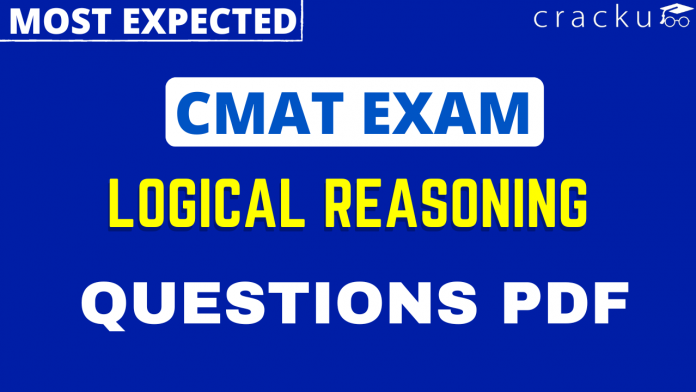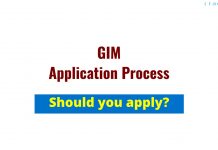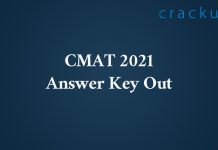Logical Reasoning is one of the most important topics in the CMAT, and also it is an important section. One can utilize this article which consists of the most important questions regarding Logical Reasoning. Cracku provides you with the Top 20 very Important Logical Reasoning Questions for CMAT based on the questions asked in previous exam papers. Click on the link below to download the Logical Reasoning Questions for CMAT PDF with detailed answers.
Download Logical Reasoning Questions for CMAT
Enroll to CMAT 2023 Crash Course
Question 1: A large solid iron sphere of diameter 10m is melted and 2/5 of the melted amount is recast into several small spheres of diameter 2m. What is the ratio of the total surface area of the smaller spheres and the surface area of the large sphere?
a) 1 : 1
b) 2 : 1
c) 3 : 1
d) 4 : 1
1) Answer (B)
Solution:
Volume of large sphere$=\frac{4\pi\ }{3}\times\ \left(\ \frac{\ 10}{2}\right)^3=\frac{4\pi\times\ 5^3\ }{3}$
2/5 of the volume is recast into several spheres of 2m diameter.
Let the number of small spheres be ‘$n$’
$n\times\ \frac{4\pi}{3}\times\ \left(\frac{2}{2}\right)^3\ =\frac{2}{5}\times\ \frac{4\pi\times\ 5^3\ }{3}$
On solving, we get $n=50$.
The ratio of the total surface area of the smaller spheres and the surface area of the large sphere= $\left(50\times\ 4\pi r^2\right)\ :\ \left(4\pi R^2\right)$
= $\left(50\times\ 4\pi\left(1\right)^2\right)\ :\ \left(4\pi\left(5\right)^2\right)$
$=2\ :\ 1$
Question 2: 
Find the area of the shaded region. Given that ABCD is a square with side length ‘b’ units and E is the midpoint of AB.
a) $\frac{\pi b^{2}}{4^{2}}[36 – 16\sqrt{3}]$
b) $\frac{\pi b^{2}}{4^{2}}[34 + 14\sqrt{5}]$
c) $\frac{\pi b^{2}}{4^{2}}[34 – 14\sqrt{5}]$
d) $\frac{\pi b^{2}}{4^{2}}[36 + 16\sqrt{3}]$
2) Answer (C)
Solution:
For Triangle ECD,
$EC=DE=\sqrt{\ b^2+\left(\frac{b}{2}\right)^2}=\frac{\sqrt{\ 5}b}{2}$
CD = b
$Area\ of\ \triangle\ ECD=r\times\ s$….(1)
$s=\frac{\left(\frac{\sqrt{\ 5}b}{2}+\frac{\sqrt{\ 5}b}{2}+b\right)}{2}=\frac{b\left(\sqrt{\ 5}+1\right)}{2}$…(2)
$Area\ of\ \triangle\ ECD\ =\ \frac{B\times\ H}{2}=\frac{b\times\ b}{2}=\frac{b^2}{2}$…….(3)
From EQ (1), (2) & (3)
we get, $\frac{b^2}{2}=\frac{b\left(\sqrt{\ 5}+1\right)}{2}\times\ r$
$\ r=\frac{b}{\sqrt{\ 5}+1}=\frac{b\left(\sqrt{\ 5}-1\right)}{4}$
Area of the incircle of ECD = $\ \pi\ r^2$
= $\ \pi\ \times\ \left(\frac{b\left(\sqrt{\ 5}-1\right)}{4}\right)^2$
$=\frac{\pi\ b^2\left(5+1-2\sqrt{\ 5}\right)}{16}=\frac{\pi\ b^2\left(3-\sqrt{\ 5}\right)}{8}$….(4)
For Triangle AED,
Inradius, $r=\frac{AE+AD-DE}{2}=\frac{b+\frac{b}{2}-\frac{\sqrt{\ 5}b}{2}}{2}=\frac{b\left(3-\sqrt{\ 5}\right)}{4}$
Area of the incircle of Triangle AED, = $\frac{\pi\ b^2\ \left(3-\sqrt{\ 5}\right)^2}{4^2}$
$=\pi\ b^2\ \frac{\left(9+5-6\sqrt{\ 5}\right)}{16}=\frac{\pi\ b^2\ \left(14-6\sqrt{\ 5}\right)}{16}$……(5)
As, Triangle AED $\simeq\ $ Triangle BEC
Area of the incircle of $\triangle\ AED$ = Area of the incircle of $\triangle\ BEC$.
Hence, the area of the shaded region $=\frac{\pi\ b^2\left(14-6\sqrt{\ 5}\right)}{16}+\frac{\pi\ b^2\left(14-6\sqrt{\ 5}\right)}{16}+\frac{\pi b^2\ \left(3-\sqrt{\ 5}\right)}{8}$
$=\frac{\pi\ b^2}{16}\times\ \left(14-6\sqrt{\ 5}+14-6\sqrt{\ 5}+6-2\sqrt{\ 5}\right)$
$=\frac{\pi\ b^2\left(34-14\sqrt{\ 5}\right)}{16}$
Question 3: 
AB and CD are two chords intersecting at point E. Ram started from point A with a speed of 2km/hr. After reaching point E, Ram moved to point D with same speed and covered ED in one-fifth of the time taken for AE. Similarly. Shyam moved from point C to point B through point E. If Shyam takes in total 18 hours to cover the whole distance from C to B through point E with same speed. what is the time Shyam took to cover BE?
a) 1.5 hours
b) 2 hours
c) 3 hours
d) 4.5 hours
3) Answer (C)
Solution:

It is given that Ram covers ED in one-fifth of the time taken for AE, with a 2km/hr constant speed.
It implies, $\frac{1}{5}\times\ \frac{AE}{2}\ =\frac{ED}{2}$
$AE\ =5\times\ ED$……(1)
Let the speed of Shyam be ‘s’ Kmph. He covers the whole distance from C to B through point E at the same speed in 18 hours.
It implies, $\frac{CE+BE}{S}=18 Hrs$…….(2)
From the properties of circles, $AE\times\ BE=CE\times\ DE$
$5DE\times\ BE=CE\times\ DE$ [From EQ(1)]
$CE=5BE$……(3)
From EQ(2) & (3)
$\frac{5BE+BE}{S}=18$
$\frac{6BE}{S}=18$
$\frac{BE}{S}=3\ Hrs.$
Option (C) is the answer.
Question 4: Two trains of equal length are running on parallel lines in the same direction at 54km/hour and 40km/hour. The slower train started first and then the faster train started after some time. The faster train passes the length of the slower train in 36 seconds completely. The length of each train is?
a) 50 m
b) 70 m
c) 80 m
d) 90 m
4) Answer (B)
Solution:
Let the length of both trains be $’x’$.
The speeds of trains are 54Kmph & 40Kmph.
The faster train passes the length of the slower train in 36 seconds.
It implies, $\frac{x+x}{54-40}=\frac{36}{60\times\ 60}$
$\frac{2x}{14}=\frac{36}{60\times\ 60}$
$x=0.07\ Km$
$x=70\ m$.
Hence, Option (B) is correct.
Question 5: A green liquid is mixed with a blue liquid in the proportion 4 : 5 and the mixture is sold at Rs. 20 per litre at a 20% profit. If the green liquid costs Rs. 4 more per litre than the blue liquid, what does the green liquid cost per litre approximately.
a) Rs. 16.33
b) Rs. 18.88
c) Rs. 17.66
d) Rs. 19.22
5) Answer (B)
Solution:
Let the cost of blue liquid per litre be $’x’$
then the cost of green liquid per litre is $’x+4’$
The S.P. of the mixture is Rs 20 per litre, and the profit % is 20%.
Then C.P. of the mixture per litre = $\frac{20}{1+0.2}=\frac{20}{1.2}=\frac{50}{3}$……(1)
Also, the C.P. of the mixture per litre is given by = $\frac{4\left(x+4\right)+5\left(x\right)}{5+4}=\frac{9x+16}{9}$…..(2)
Equating (1) to (2)
we get $\frac{50}{3}=\frac{9x+16}{9}$
$150=9x+16$
$9x=134$
$x=14.88$
Hence, the cost of green liquid per litre is = 14.88+4= 18.88.
Option (B) is correct.
Question 6: Let a – d, a, a + d, a + 2d be four terms of an arithmetic progression with integer entries and a, a + d, a + 2d, a + 3d be another four terms of the same arithmetic progression. Let $x = a(a – d) (a + d) (a + 2d) + d^4$ and $y = a(a + d) (a + 2d) (a + 3d) + d^4$. Then x + y is equal to ?
a) $(a^2 – d^2 + 5ad)^2 + (2a^2 – 3ad)^2$
b) $(a^2 – 2d^2 + 2ad)^2 + (2a^2 – d^2 – ad)^2$
c) $(a^2 + 3d^2 – ad)^2 + (a^2 + d^2)^2$
d) $(a^2 + d^2 + 3ad)^2 + (a^2 – d^2 + ad)^2$
6) Answer (D)
Solution:
Given that $x = a(a – d) (a + d) (a + 2d) + d^4$
$x=a\left(a-d\right)\left(a+d\right)\left(a+2d\right)+d^4$
$=a\left(a+d\right)\left(a-d\right)\left(a+2d\right)+d^4$
$=\left(a^2+ad\right)\left(a^2+2ad-ad-2d^2\right)+d^4$
Let $t=a^2+ad$
$x=\left(t\right)\left(t-2d^2\right)+d^4$
$x=t^2-2td^2+d^4$
$x=\left(t-d^2\right)^2$
Substituting $t=a^2+ad$
$x=\left(a^2+ad-d^2\right)^2$………(1)
Given that, $y = a(a + d) (a + 2d) (a + 3d) + d^4$
$y=a\left(a+d\right)\ \left(a+2d\right)\ \left(a+3d\right)+d^4$
$=a\left(a+3d\right)\ \left(a+d\right)\ \left(a+2d\right)+d^4$
$=\left(a^2+3ad\right)\ \left(a^2+2ad+ad+2d^2\right)+d^4$
$=\left(a^2+3ad\right)\ \left(a^2+3ad+2d^2\right)+d^4$
Let $t=a^2+3ad$
$=\left(t\right)\ \left(t+2d^2\right)+d^4$
$=t^2+2td^2+d^4$
$=\left(t+d^2\right)^2$
Substituting $t=a^2+3ad$
$y=\left(a^2+3ad+d^2\right)^2$………(2)
From Eq (1) & (2)
We get, $x+y=\left(a^2-d^2+ad\right)^2+\left(a^2+d^2+3ad\right)^2$
Option (D) is correct.
Question 7: A person standing on the bank of a river observes that the angle subtended by a tree on the opposite bank is 60 degrees. When he retires ‘y’ metre from the bank perpendicular to the tree, he finds the angle to be 45 degrees. When he further retires $15 – 5\sqrt{3}$ metre perpendicular to the tree, he finds the angle to be 30 degrees. Find the height of the tree in metres?
a) $10\sqrt{3}$
b) $15 + \sqrt{3}$
c) $5\sqrt{3}$
d) $15 – \sqrt{3}$
7) Answer (C)
Solution:
It is given that $\angle\ OAM=60^{\circ\ },\ \angle\ OBM=45^{\circ},\ \angle\ OCM=30^{\circ\ },\ AB=y,\ BC=15-5\sqrt{\ 3}\ $
Let the height of the tree be OM = $’h’$.
Then $AM\ =\frac{OM}{\tan\ 60^{\circ\ }}=\frac{h}{\sqrt{\ 3}}$
From $\triangle\ OBM,\ \tan\ 45^{\circ\ }=\frac{h}{\frac{h}{\sqrt{\ 3}}+y}$
$\frac{h}{\sqrt{\ 3}}+y=h$
$y=h-\frac{h}{\sqrt{\ 3}}$
From $\triangle\ OCM,\ \tan30^{\circ\ }=\frac{h}{15-5\sqrt{\ 3}+y+\frac{h}{\sqrt{\ 3}}}$
$\frac{1}{\sqrt{\ 3}}=\frac{h}{15-5\sqrt{\ 3}+h-\frac{h}{\sqrt{\ 3}}+\frac{h}{\sqrt{\ 3}}}$
$\frac{1}{\sqrt{\ 3}}=\frac{h}{15-5\sqrt{\ 3}+h}$
$15-5\sqrt{\ 3}+h=h\sqrt{\ 3}$
$15-5\sqrt{\ 3}=h\left(\sqrt{\ 3}-1\right)$
$h=\frac{15-5\sqrt{\ 3}}{\left(\sqrt{\ 3}-1\right)}$
$h=\frac{5\sqrt{\ 3}\times\ \left(\sqrt{\ 3}-1\right)}{\left(\sqrt{\ 3}-1\right)}=5\sqrt{\ 3}$
Option (C) is the answer.
Question 8: Find $\tan^4 \alpha + \tan^4 \gamma$ using the information given below:
$\tan(\theta – \gamma) = \frac{1}{\sqrt{2}}, \tan \theta \tan \gamma = \tan^2 \alpha$
a) $\frac{\tan^2 \gamma}{2}\left[\left(\tan^2 \alpha + 3\right)^2 – 8\right]$
b) $\frac{\tan^2 \gamma}{2}\left[\left(\tan^2 \alpha – 3\right)^2 + 8\right]$
c) $\frac{\tan^2 \gamma}{2}\left[\left(3\tan^2 \alpha + 1\right)^2 – 4\right]$
d) $\frac{\tan^2 \gamma}{2}\left[\left(3\tan^2 \alpha – 3\right)^2 + 4\right]$
8) Answer (A)
Solution:
Given that,
$\tan\left(\theta\ -\gamma\ \right)=\frac{1}{\sqrt{\ 2}}$
$\frac{\tan\theta-\tan\gamma}{1+\tan\theta\ \tan\gamma\ }\ =\frac{1}{\sqrt{\ 2}}$
$\frac{\tan\theta-\tan\gamma}{1+\tan^2\alpha\ }\ =\frac{1}{\sqrt{\ 2}}$
$\frac{\tan\theta-\tan\gamma}{\sec^2\alpha\ }\ =\frac{1}{\sqrt{\ 2}}$
$\ \tan\theta\ -\tan\gamma\ =\frac{1}{\sqrt{\ 2}\cos^2\alpha\ }$
$\ \frac{\tan^2\alpha\ }{\tan\gamma\ }-\tan\gamma\ =\frac{1}{\sqrt{\ 2}\cos^2\alpha\ }$
$\ \tan^2\alpha\ -\tan^2\gamma\ =\frac{\tan\gamma\ }{\sqrt{\ 2}\cos^2\alpha\ }$
Squaring on both sides,
$\tan^4\alpha\ +\tan^4\gamma-2\ \tan^2\alpha\ \tan^2\gamma\ =\frac{\tan^2\gamma\ }{2\cos^4\alpha\ }$
$\tan^4\alpha\ +\tan^4\gamma\ =2\ \tan^2\alpha\ \tan^2\gamma+\frac{\tan^2\gamma\ }{2\cos^4\alpha\ }$
$\tan^4\alpha\ +\tan^4\gamma\ =\tan^2\gamma\ \left(2\ \tan^2\alpha\ +\frac{1}{2\cos^4\alpha\ }\right)$
$\tan^4\alpha\ +\tan^4\gamma\ =\tan^2\gamma\ \left(\ \frac{4\sin^2\alpha\ \cos^2\alpha}{2\cos^4\alpha}\ +\frac{1}{2\cos^4\alpha\ }\right)$
$\tan^4\alpha\ +\tan^4\gamma\ =\frac{\tan^2\gamma}{2}\ \left(\ \frac{4\sin^2\alpha\ \cos^2\alpha+1}{\cos^4\alpha}\ \right)$
$=\frac{\tan^2\gamma}{2}\ \left(\ \frac{6\sin^2\alpha\ \cos^2\alpha+1-2\sin^2\alpha\ \cos^2\alpha}{\cos^4\alpha}\ \right)$
$=\frac{\tan^2\gamma}{2}\ \left(\ \frac{6\sin^2\alpha\ \cos^2\alpha+\left(\sin^2\alpha\ +\cos^2\alpha\right)^2-2\sin^2\alpha\ \cos^2\alpha}{\cos^4\alpha}\ \right)$
$=\frac{\tan^2\gamma}{2}\ \left(\ \frac{6\sin^2\alpha\ \cos^2\alpha+\sin^4\alpha\ +\cos^4\alpha+2\sin^2\alpha\ \cos^2\alpha-2\sin^2\alpha\ \cos^2\alpha}{\cos^4\alpha}\ \right)$
$=\frac{\tan^2\gamma}{2}\ \left(\ \frac{6\sin^2\alpha\ \cos^2\alpha+\sin^4\alpha\ +\cos^4\alpha}{\cos^4\alpha}\ \right)$
$=\frac{\tan^2\gamma}{2}\ \left(\ 6\tan^2\alpha+\tan^4\alpha\ +1\ \right)$
$=\frac{\tan^2\gamma}{2}\ \left(\ \left(\tan^2\alpha+3\right)^2\ -8\ \right)$
Option (A) is the answer.
Question 9: It is given that $P(A \cup B) < \frac{3}{4}, P(A) > \frac{1}{8}, P\left(\frac{A}{B}\right) < \frac{1}{2}$. Which of the following is true?
a) $P(A \cap B) + P(A) > \frac{7}{8}$
b) $P(A \cap B) + P(A) > \frac{3}{4}$
c) $P(A \cap B) < \frac{5}{8}$
d) $P(A \cap B) > \frac{7}{8}$
9) Answer (C)
Solution:
It is given that, $P(A \cup B) < \frac{3}{4}, P(A) > \frac{1}{8}, P\left(\frac{A}{B}\right) < \frac{1}{2}$
$P\left(\frac{A}{B}\right)=\frac{P(A \cap B)}{P\left(B\right)}< \frac{1}{2}$
$2\ P(A \cap B) < P(B)$
$P(A \cap B) < P(B)-P(A \cap B)$………(1)
$ P(A \cup B) = P(A) + P(B) – P(A \cap B) < \frac{3}{4}$
$ P(A) + P(B) – P(A \cap B) < \frac{3}{4}$
$ P(A) + (P(A \cap B) <) < \frac{3}{4}$ From Eq (1),
$ P(A) + P(A \cap B) < \frac{3}{4}$
Hence Options (A), (B) & (D) are false.
$ P(A) + P(A \cap B) < \frac{3}{4}$
$ (> \frac{1}{8}) + P(A \cap B) < \frac{3}{4}$ From $(P(A) > \frac{1}{8})$
$P(A \cap B) < \frac{3}{4}-\frac{1}{8}$
$P(A \cap B) < \frac{5}{8}$
Option (C) is correct.
Question 10: In 1920, the “Sahitya Shakti” society was established by 500 members who read Premchand. In 1921, due to internal conflict, it removed all 200 members who also read Shakespeare. In 1922, further the member who also read Tolstoy numbering 100 left the society. In 1923, the society added only those ex-member who read both Shakespeare and Premchand but not Tolstoy after which the Sahitya Shakti society consisted of 350 members. Which of the following is true?
a) 200 original members read both Premchand and Tolstoy
b) 50 original members read together Premchand and Shakespeare and Tolstoy
c) 300 original members read both Premchand and Shakespeare but not Tolstoy
d) 150 original members read both Shakespeare and Tolstoy
10) Answer (B)
Solution:
The total number of members of Sahitya Shakti is 500.
Total members after removing people who read Shakespeare = 500-200=300
Total members after removing people who read Tolstoy = 300-100=200
Society added back people who read Shakespeare but not Tolstoy, and the number increased to 350.
Hence society added back 150 people. But initially, society removed 200 members.
Therefore, the other 50 members who were not added back also read Tolstoy. Those 50 members read all three books.
Option (A) False. Only 150 original members read both Premchand and Tolstoy.
Option(B) True. 50 original members read together Premchand and Shakespeare and Tolstoy
Option(C) False. 350 original members read both Premchand and Shakespeare but not Tolstoy
Option (D) False. 50 original members read both Shakespeare and Tolstoy
Question 11: Pot “A” contains 5 blue and 10 green balls and another pot “B” contains 7 blue and 2 green balls. A biased dice with six sides numbered 1 to 6 is rolled. The probability of eah odd out ome is same and the probability of each even outcome is same. But the probability of an odd outcome is twice than the probability of an even outcome. If the face 1 or 2 or 3 comes up, a ball is taken from the pot “A” else a ball is taken from the pot “B”. Find the probability of drawing a green ball.
a) $\frac{38}{81}$
b) $\frac{33}{81}$
c) $\frac{28}{81}$
d) $\frac{25}{81}$
11) Answer (A)
Solution:
Let the probability of an even outcome of dice be $’x’$.
Then the probability of the odd outcome of the dice is $’2x’$.
The sum of all probabilities of all events is 1.
It implies $x+x+x+2x+2x+2x=1$
$x=\frac{1}{9}$
Probability of drawing a green ball from pot ‘A’ = Probability of selecting pot ‘A’ x probability of drawing a green ball.
= $\left(\frac{2}{9}+\frac{1}{9}+\frac{2}{9}\right)\times\ \frac{10}{15}$ =$=\frac{5}{9}\times\ \frac{10}{15}=\frac{10}{27}$
Similarly, the Probability of drawing a green ball from pot ‘B’ = $\left(\frac{1}{9}+\frac{2}{9}+\frac{1}{9}\right)\times\ \frac{2}{9}$
= $=\frac{4}{9}\times\ \frac{2}{9}=\frac{8}{81}$
Probability of drawing a green ball = Probability of drawing a green ball from pot ‘A’ +Probability of drawing a green ball from pot ‘B’.
= $=\frac{10}{27}+\ \frac{8}{81}=\frac{38}{81}$
Option (A) is the answer.
Question 12: An n-digit number is a positive number with exactly n digits. Nine hundred distinct n-digit numbers are to be formed using digits 2,3,4,5 and 7 such that each n-digit number has the
(i) first and last digits are the same
(ii) first and third are prime numbers
(iii) second should be greater than or equal to 4.
What should be the minimum value of n such that the above is possible?
a) 5
b) 6
c) 7
d) 8
12) Answer (B)
Solution:
Let’s consider an n-digit number.
$_{————-n\ digits}$
The 900 distinct numbers have to be formed using digits 2, 3, 4, 5 and 7.
The first and last digit numbers are the same & the first and third are prime numbers
$abc_{———–}a\ total\ ‘n’\ digits.$
the values of a & c can be anything from 2,3,5, and 7. i.e 4 values.
The second digit should be greater than or equal to 4. Hence, b can take any value from 4, 5 & 7. i.e. 3 values.
There are no conditions from the 4th digit to the ‘n-1’ digit.
Hence those digits can take any value from 2, 3, 4, 5 and 7, i.e. 5 values.
For n = 4, the number of digits that can be formed $=4\times\ 4\times\ 3=48 < 900$
For n = 5, the number of digits that can be formed $=4\times\ 4\times\ 3\times\ 5 = 240 < 900$
For n = 6, the number of digits that can be formed $=4\times\ 4\times\ 3\times\ 5\times\ 5=1200 > 900$
Hence a minimum of 6-digit number is required to form 900 distinct numbers with given conditions.
Option (B) is correct.
Question 13: An integer is called a perfect square if it is square of another integer. The number of perfect square points (i.e. both coordinates are perfect squares that lie exactly within the circle
$(x – 12)^2 + (y – 10)^2 = 64$ is
a) 8
b) 4
c) 6
d) 10
13) Answer (C)
Solution:
The given equation is $(x – 12)^2 + (y – 10)^2 = 64$
$(x – 12)^2 + (y – 10)^2 = 8^2$
It is an equation of a circle with a radius of 8 units & its centre is at (12,10).
It implies that the extreme coordinate of ‘x’ is = 12+8 = 20.
Similarly, the extreme coordinate of ‘y’ is = 10+8 = 18.
The square numbers which are less than 20 & 18 are 4, 9 & 16.
For a point (x,y) to lie inside the circle, $(x – 12)^2 + (y – 10)^2 = 64$, the value of $(x – 12)^2 + (y – 10)^2$ should be less than 64.
Case (i):- (4,4)
$(4-12)^2+(4-10)^2=8^2+6^2=100 > 64$.
Hence, the point lies outside the circle.
As $(4-12)^2=64$, all the square points with ‘4’ as x coordinate i.e (4,9), (4,16), lie outside the circle.
Case (ii):- (9,9)
$(9-12)^2+(9-10)^2=3^2+1^2=10 < 64$.
Hence, the point lies inside the circle.
Case (iii):- (16,16)
$(16-12)^2+(16-10)^2=4^2+6^2=52 < 64$.
Hence, the point lies inside the circle.
Case (iv):- (9,4)
$(9-12)^2+(4-10)^2=3^2+6^2=45 < 64$.
Hence, the point lies inside the circle.
Case (v):- (9,16)
$(9-12)^2+(16-10)^2=3^2+6^2=45 < 64$.
Hence, the point lies inside the circle.
Case (vi):- (16, 4)
$(16-12)^2+(4-10)^2=4^2+6^2=52 < 64$.
Hence, the point lies inside the circle.
Case (vii):- (16, 16)
$(16-12)^2+(16-10)^2=4^2+6^2=52 < 64$.
Hence, the point lies inside the circle.
A total of 6 perfect square points lie inside the circle.
Option ‘C’ is the answer.
Question 14: Find the value of x such that
$(1 – x)^{\frac{3}{2}} + (1 + x)^{\frac{3}{2}} + 2(\sqrt{1 – x^2}) = (2 + 2\sqrt{1 – x^2})^{\frac{3}{2}}$
a) $\frac{5}{11}\sqrt{7}$
b) $\frac{1}{5}\sqrt{3}$
c) $\frac{3}{7}\sqrt{5}$
d) $\frac{4}{9}\sqrt{2}$
14) Answer (D)
Solution:
Let $\sqrt{\ 1-x}=a\ \&\ \sqrt{\ 1+x}=b$
R.H.S = $(2 + 2\sqrt{1 – x^2})^{\frac{3}{2}}$
=$(1+x+1-x + 2\sqrt{(1 – x)(1+x)})^{\frac{3}{2}}$
=$(a^2+b^2+ 2ab)^{\frac{3}{2}}$
=$\left(a+b\right)^{2\times\ \frac{3}{2}}$
=$\left(a+b\right)^3$
L.H.S = $(1 – x)^{\frac{3}{2}} + (1 + x)^{\frac{3}{2}} + 2(\sqrt{1 – x^2})$
= $a^3+b^3+2ab$
=$\left(a+b\right)^3-3ab(a+b)+2ab$
Equating L.H.S & R.H.S, we get
$\left(a+b\right)^3-3ab(a+b)+2ab = \left(a+b\right)^3$
$a+b=\frac{2}{3}$
substituting the values of ‘a’ & ‘b’ we get
$\sqrt{\ 1-x}+\sqrt{\ 1+x}=\frac{2}{3}$
squaring on both sides, we get
$1-x+1+x+2\sqrt{\ 1-x^2}=\frac{4}{9}$
$2\sqrt{\ 1-x^2}=\frac{4}{9}-2$
$\sqrt{\ 1-x^2}=\frac{-7}{9}$
Squaring on both sides
$1-x^2=\frac{49}{81}$
$x^2=\frac{32}{81}$
$x=\frac{4\sqrt{\ 2}}{9}$
Hence, option (D) is the answer.
Question 15: Let integer $\alpha$ be one of the roots of $ax^2 + 2x + 3 = 0$ and integer $\beta$ be one of the roots of $5x^2 + bx + 8 = 0$. It is also given that $\alpha = \beta^2$. Which of the following statement is true if $b = -14$?
a) $32b + 8a^2b – 64ab = -175$
b) $32a + 16ab^2 + 16ab = 275$
c) $64b + 8ab^2 – 8ab = 175$
d) $64a + 4ab^2 + 32ab = -275$
15) Answer (D)
Solution:
$64\times\ \frac{-11}{16}+4\times\ -\frac{11}{16}\times\ 4^2+32\times\ -\frac{11}{16}\times\ 4$It is given that b=-14.
Then the eq $5x^2 + bx + 8 = 0$ becomes $5x^2 -14x + 8 = 0$.
$x=\frac{-b\pm\ \sqrt{\ b^2-4ac}}{2a}=\frac{14\pm\ \sqrt{\ 196-160}}{10}$
$=\frac{14\pm\ 6}{10}$
$x=2\ or\ 0.8$
It is given that $\beta\ $ is an integer & a root of $ 5x^2 + bx + 8 = 0$.
Hence $\beta=2$.
If $\beta=2$, Then $\alpha = \beta^2$ = $4$.
As $\alpha$ is a root of $ax^2 + 2x + 3 = 0$
$4^2a+8+3=0$
$a=-\frac{11}{16}$.
By verifying options, Option D satisfies for the a & b values.
= $64\times\ \frac{-11}{16}+4\times\ -\frac{11}{16}\times\ \left(-14\right)^2+32\times\ -\frac{11}{16}\times\ -14$
$=\ -275$
Hence Option (D) is the answer.
Question 16: 
Four sprinters start running from 4 points which are 4 corners of an imaginary rectangle along straight lines and meet at a point ‘O’ which falls inside the rectangle as shown in the figure, after the first three sprinters run 55m, 65m and 75m respectively. What is the approximate distance that the fourth sprinter will run to meet the other three sprinters at point O?
a) 66.5 m
b) 50.5 m
c) 48.5 m
d) 68.5 m
16) Answer (A)
Solution:

From the above figure,
Using Pythagoras theorem
$In\ \triangle\ AQO\ ,\ 55^2=a^2+c^2$…..(1)
similarly.
$In\ \triangle\ BQO\ ,\ 65^2=a^2+d^2$…..(2)
$In\ \triangle\ CSO\ ,\ 75^2=b^2+d^2$…..(3)
$In\ \triangle\ DSO\ ,\ m^2=b^2+c^2$…..(4)
From observation, Eq(1)-Eq(2) = Eq(4)-Eq(3) = $c^2-d^2$
Hence, $55^2-65^2=m^2-75^2$
$3025-4225=m^2-5625$
$m^2=4425$
$m=\pm\ 66.52$
As ‘m’ cannot be negative
$m\approx\ \ 66.5$
Option (A) is correct.
Question 17: Find the largest 5 digit number which when divided by 4, 9, and 11 leaves the same but largest remainder for all the three numbers ?
a) 99785
b) 99945
c) 99965
d) 99795
17) Answer (D)
Solution:
The largest remainder we can get, = smallest of {largest remainder of ‘4’, the largest remainder of ’11’, the largest remainder of ‘9’}
= smallest of {3,10,8} = 3.
The number which gives the remainder ‘3’, when divided by 4,9& 11, will be of the form = L.C.M of (4,9&11) x n + 3.
L.C.M of (4,9&11) = 396.
The number which gives the remainder ‘3’, when divided by 4,9& 11, will be of the form = 396n+3.
The largest 5-digit number of the form, 396n+3 = 396 x 252 + 3
=99792+3=99795.
Option (D) is correct.
Question 18: An investor lent-out a certain sum on simple interest and the same sum on compound interest at the same rate of interest per annum. He noticed that the ratio of the difference of the compound interest and the simple interest for 4 years to the difference of the compound interest and the simple interest for 3 years is 20:8. The approximate rate of interest per annum is given by,
a) 69%
b) 54%
c) 77%
d) 41%
18) Answer (A)
Solution:
Let ‘$p$’ be the principal amount and ‘$r$’ be the interest rate per annum.
Simple Interest for t years = $ptr$
Compound Interest for t years = $p\left(1+r\right)^t-p$
From the given information,
$\frac{\left(p\left(1+r\right)^4-p\right)-4pr}{\left(p\left(1+r\right)^3-p\right)-3pr}=\frac{20}{8}$
$\frac{\left(\left(1+r\right)^4-1\right)-4r}{\left(\left(1+r\right)^3-1\right)-3r}=\frac{5}{2}$
$2\times\ \left(\left(1+r\right)^4-1-4r\right)=5\times\ \left(\left(1+r\right)^3-1-3r\right)$
$2\times\ \left(1+r\right)^4-2-8r=5\times\ \left(1+r\right)^3-5-15r$
$2\times\ \left(1+r\right)^4=5\times\ \left(1+r\right)^3-3-7r$
$\ 2r^4+8r^3+12r^2+8r+2=\ 5r^3+15r^2+15r+5-3-7r$
$\ 2r^4+8r^3+12r^2=\ 5r^3+15r^2$
$\ 2r^2+3r-3=0$
Hence, $r=\frac{-3\pm\ \sqrt{\ 9+24}}{2\times\ 2}$
$r=\frac{-3\pm\ \sqrt{\ 33}}{4}$
As interest rate cannot be negative,
$r=\frac{-3+\ \sqrt{\ 33}}{4}$
$r=0.6861$
Hence, the approximate value of $r=69\%$
Option (A) is correct.
Question 19: The cost of setting up a utility bag factory is Rs. 1200. The cost of running the factory is Rs. 125 per 105 bags. The cost of raw material is 80 paise/per bag. The bag are old at Rs. 3.25 each. 900 bags were made, but only 785 bags were sold. Other companies can advertise on both sides of the bag. What is the approximate sum to be obtained from the advertisements being printed on the bags, to give a profit of 12%?
a) Rs. 700
b) Rs. 785
c) Rs. 799
d) Rs. 840
19) Answer (C)
Solution:
It is given that 900 bags were made, and only 785 were sold.
Cost of manufacturing 900 bags $=1200+\frac{125}{105}\times\ 900+0.80\times\ 900$ $=\ Rs. \frac{20940}{7}$…..(1)
Revenue of the factory = Amount from sales + Amount from advertisements……(2)
Let the amount from advertisements be $ Rs. ‘y’$
Amount from sales = $785\times\ 3.25= Rs. 2551.25$
Factory’s profit percentage = 12%…..(3)
From Eq (1), (2) & (3)
We get, $2551.25\ +y=\frac{20940}{7}\ \times\ 1.12$
On solving, we get $y=Rs.\ 799.15$
Hence the approximate revenue from advertisements is = $Rs.\ 799$
Option (C) is the answer.
Question 20: The sides of a triangle are 21, 20 and 13 cm. The given triangle is divided into two triangles by the perpendi ular on the longest side from the opposite vertex. What is value of 30% area of the smaller triangle formed?
a) 96 $cm^2$
b) 30 $cm^2$
c) 9 $cm^2$
d) 3 $cm^2$
20) Answer (C)
Solution:
Let the lengths of BD, CD and AD be $x,\ y\ \&\ h$, respectively.

=> $ BD+CD = x+y=21$…..(1)
As AD is altitude, using Pythagoras’ theorem, we get
$13^2=x^2+h^2$ …..(2)
$20^2=y^2+h^2$…..(3)
Eq (3) – (2) gives
$20^2-13^2=y^2-x^2$
$231=\left(y-x\right)\ \left(y+x\right)$
$\left(y-x\right)=\frac{231}{x+y}=\frac{231}{21}=\ 11$……(4)
Adding Eq(1) & (4), we get $2y=32$ => $y=16 cm$
we get $x+16=21$ => $x=5 cm$
From Eq(2) => $13^2=5^2+h^2$
$h^2=13^2-5^2$ => $h=12 cm$
The area of the smaller triangle ABD = $\ \frac{\ BD\times\ AD}{2}$
= $\ \frac{\ 5\times\ 12}{2}$ = $30 cm^2$
30% of area of smaller triangle = $30\%\ \times\ 30=9\ cm^2$
Option (C) is the answer





